A Critical Evaluation of Supply Chain Resilience Learning Mechanisms
VerifiedAdded on 2023/06/11
|7
|1703
|397
Essay
AI Summary
This essay provides a critical evaluation of the research report 'Building routines for non-routine events: supply chain resilience learning mechanisms and their antecedents,' focusing on the factors influencing supply chain resilience (SCR). The critique summarizes the research, which explores how organizations strengthen their supply chain processes in response to disruptive non-routine events, emphasizing the role of organizational learning and knowledge management. The analysis highlights the research's structure, methodology involving qualitative case studies and interviews, and findings related to learning applied during different stages of supply chain disruptions. The essay identifies both positive aspects, such as the simplified presentation of complex topics and the consideration of accidental learning, and negative aspects, including limited scope regarding inventory management and supplier involvement, ultimately concluding that the report is well-written but with areas for improvement.
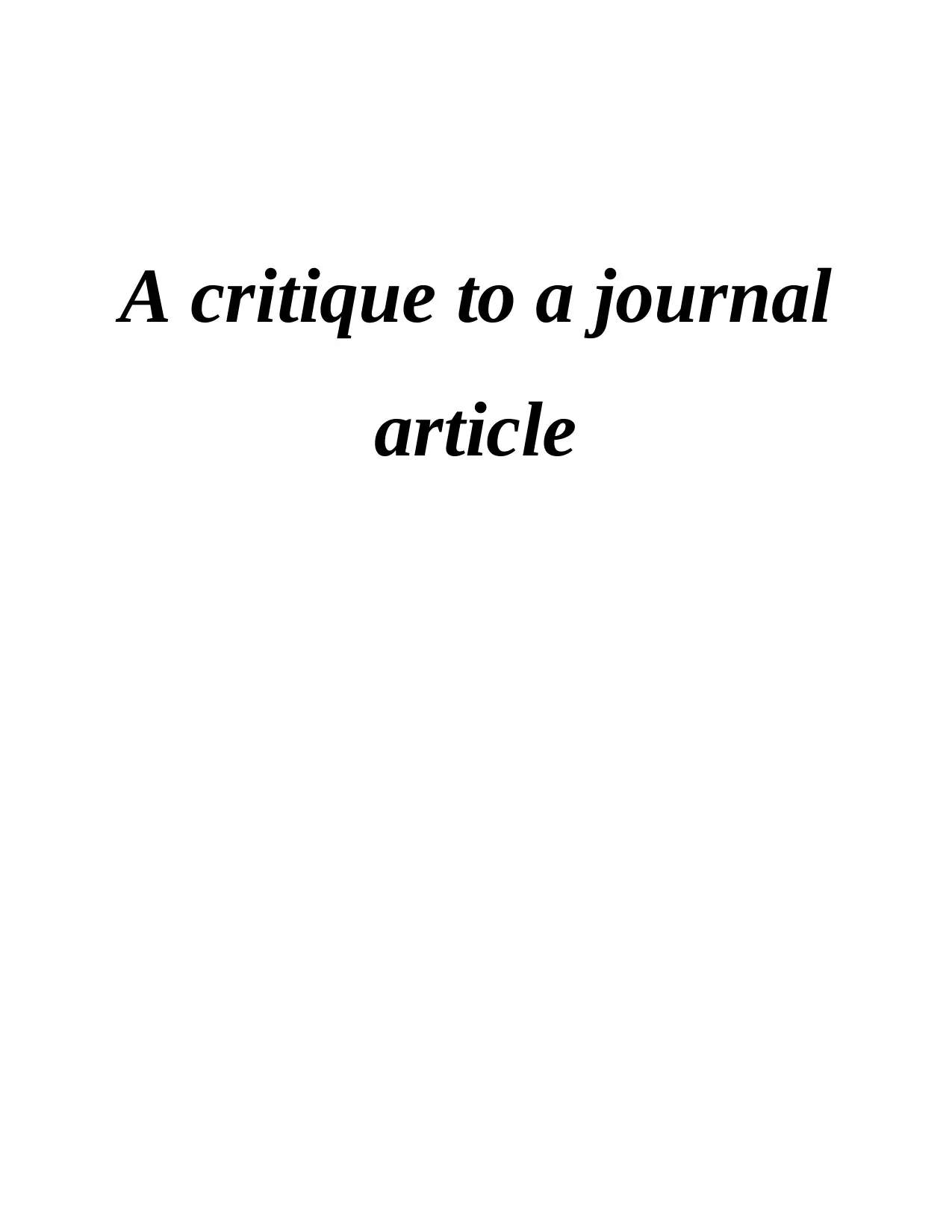
A critique to a journal
article
article
Paraphrase This Document
Need a fresh take? Get an instant paraphrase of this document with our AI Paraphraser
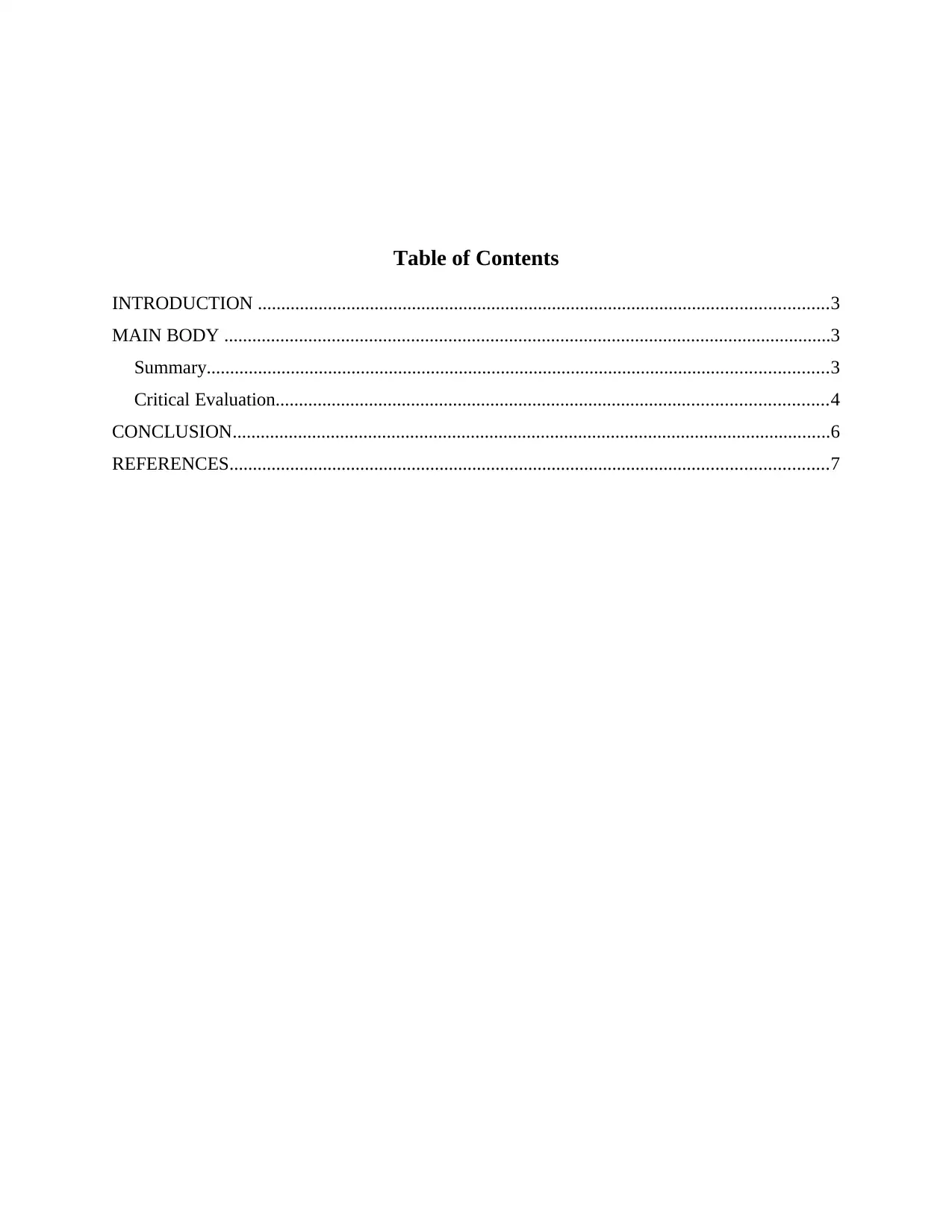
Table of Contents
INTRODUCTION ..........................................................................................................................3
MAIN BODY ..................................................................................................................................3
Summary.....................................................................................................................................3
Critical Evaluation......................................................................................................................4
CONCLUSION................................................................................................................................6
REFERENCES................................................................................................................................7
INTRODUCTION ..........................................................................................................................3
MAIN BODY ..................................................................................................................................3
Summary.....................................................................................................................................3
Critical Evaluation......................................................................................................................4
CONCLUSION................................................................................................................................6
REFERENCES................................................................................................................................7
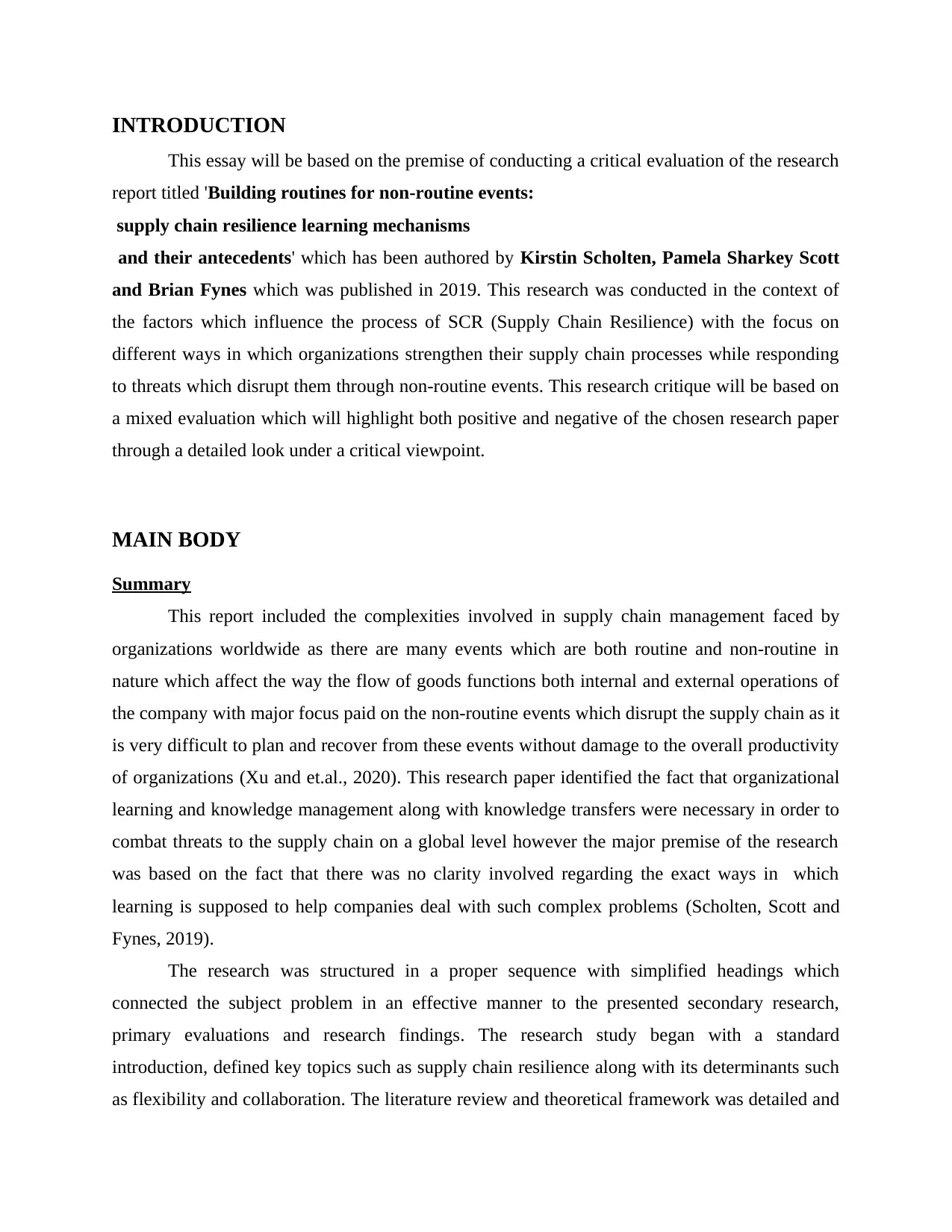
INTRODUCTION
This essay will be based on the premise of conducting a critical evaluation of the research
report titled 'Building routines for non-routine events:
supply chain resilience learning mechanisms
and their antecedents' which has been authored by Kirstin Scholten, Pamela Sharkey Scott
and Brian Fynes which was published in 2019. This research was conducted in the context of
the factors which influence the process of SCR (Supply Chain Resilience) with the focus on
different ways in which organizations strengthen their supply chain processes while responding
to threats which disrupt them through non-routine events. This research critique will be based on
a mixed evaluation which will highlight both positive and negative of the chosen research paper
through a detailed look under a critical viewpoint.
MAIN BODY
Summary
This report included the complexities involved in supply chain management faced by
organizations worldwide as there are many events which are both routine and non-routine in
nature which affect the way the flow of goods functions both internal and external operations of
the company with major focus paid on the non-routine events which disrupt the supply chain as it
is very difficult to plan and recover from these events without damage to the overall productivity
of organizations (Xu and et.al., 2020). This research paper identified the fact that organizational
learning and knowledge management along with knowledge transfers were necessary in order to
combat threats to the supply chain on a global level however the major premise of the research
was based on the fact that there was no clarity involved regarding the exact ways in which
learning is supposed to help companies deal with such complex problems (Scholten, Scott and
Fynes, 2019).
The research was structured in a proper sequence with simplified headings which
connected the subject problem in an effective manner to the presented secondary research,
primary evaluations and research findings. The research study began with a standard
introduction, defined key topics such as supply chain resilience along with its determinants such
as flexibility and collaboration. The literature review and theoretical framework was detailed and
This essay will be based on the premise of conducting a critical evaluation of the research
report titled 'Building routines for non-routine events:
supply chain resilience learning mechanisms
and their antecedents' which has been authored by Kirstin Scholten, Pamela Sharkey Scott
and Brian Fynes which was published in 2019. This research was conducted in the context of
the factors which influence the process of SCR (Supply Chain Resilience) with the focus on
different ways in which organizations strengthen their supply chain processes while responding
to threats which disrupt them through non-routine events. This research critique will be based on
a mixed evaluation which will highlight both positive and negative of the chosen research paper
through a detailed look under a critical viewpoint.
MAIN BODY
Summary
This report included the complexities involved in supply chain management faced by
organizations worldwide as there are many events which are both routine and non-routine in
nature which affect the way the flow of goods functions both internal and external operations of
the company with major focus paid on the non-routine events which disrupt the supply chain as it
is very difficult to plan and recover from these events without damage to the overall productivity
of organizations (Xu and et.al., 2020). This research paper identified the fact that organizational
learning and knowledge management along with knowledge transfers were necessary in order to
combat threats to the supply chain on a global level however the major premise of the research
was based on the fact that there was no clarity involved regarding the exact ways in which
learning is supposed to help companies deal with such complex problems (Scholten, Scott and
Fynes, 2019).
The research was structured in a proper sequence with simplified headings which
connected the subject problem in an effective manner to the presented secondary research,
primary evaluations and research findings. The research study began with a standard
introduction, defined key topics such as supply chain resilience along with its determinants such
as flexibility and collaboration. The literature review and theoretical framework was detailed and
⊘ This is a preview!⊘
Do you want full access?
Subscribe today to unlock all pages.

Trusted by 1+ million students worldwide
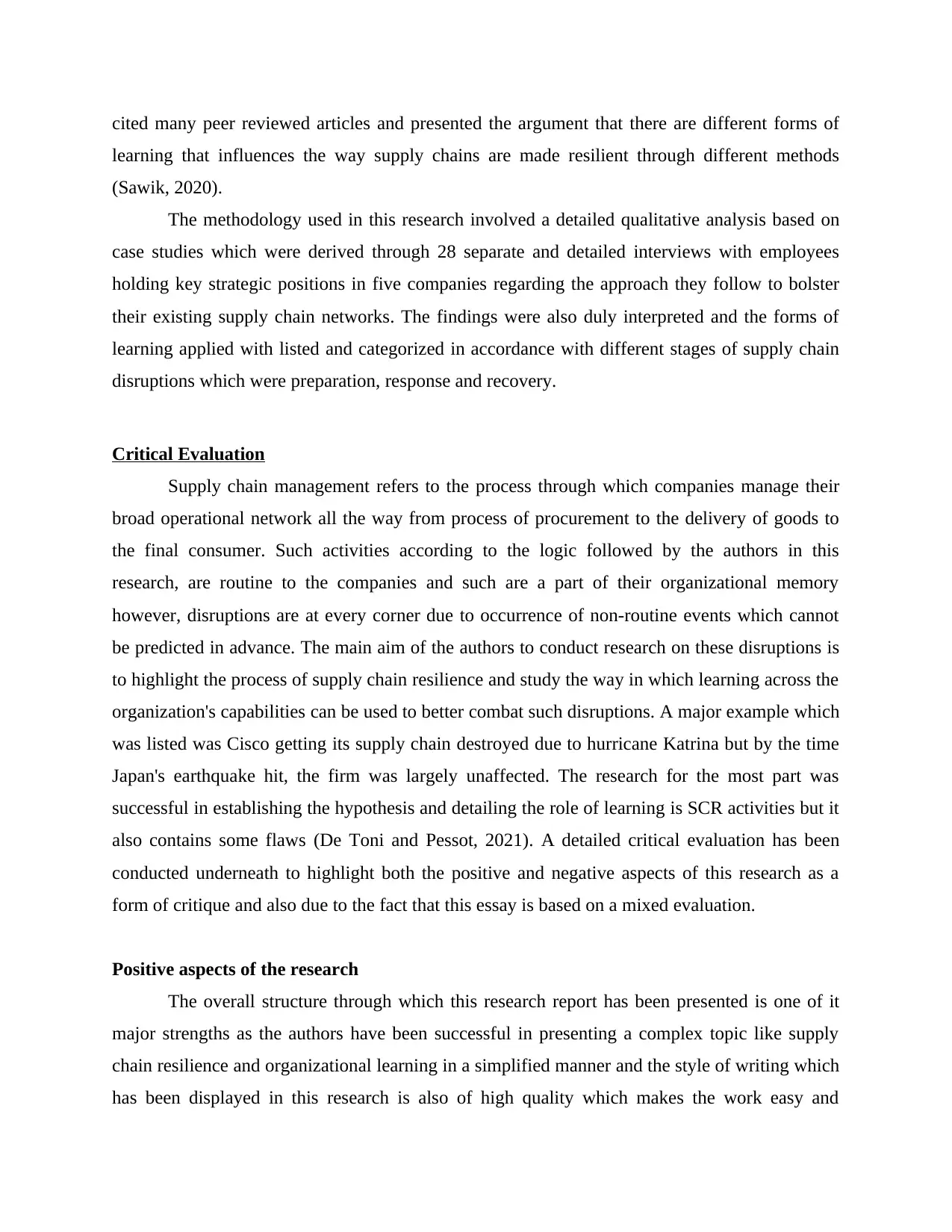
cited many peer reviewed articles and presented the argument that there are different forms of
learning that influences the way supply chains are made resilient through different methods
(Sawik, 2020).
The methodology used in this research involved a detailed qualitative analysis based on
case studies which were derived through 28 separate and detailed interviews with employees
holding key strategic positions in five companies regarding the approach they follow to bolster
their existing supply chain networks. The findings were also duly interpreted and the forms of
learning applied with listed and categorized in accordance with different stages of supply chain
disruptions which were preparation, response and recovery.
Critical Evaluation
Supply chain management refers to the process through which companies manage their
broad operational network all the way from process of procurement to the delivery of goods to
the final consumer. Such activities according to the logic followed by the authors in this
research, are routine to the companies and such are a part of their organizational memory
however, disruptions are at every corner due to occurrence of non-routine events which cannot
be predicted in advance. The main aim of the authors to conduct research on these disruptions is
to highlight the process of supply chain resilience and study the way in which learning across the
organization's capabilities can be used to better combat such disruptions. A major example which
was listed was Cisco getting its supply chain destroyed due to hurricane Katrina but by the time
Japan's earthquake hit, the firm was largely unaffected. The research for the most part was
successful in establishing the hypothesis and detailing the role of learning is SCR activities but it
also contains some flaws (De Toni and Pessot, 2021). A detailed critical evaluation has been
conducted underneath to highlight both the positive and negative aspects of this research as a
form of critique and also due to the fact that this essay is based on a mixed evaluation.
Positive aspects of the research
The overall structure through which this research report has been presented is one of it
major strengths as the authors have been successful in presenting a complex topic like supply
chain resilience and organizational learning in a simplified manner and the style of writing which
has been displayed in this research is also of high quality which makes the work easy and
learning that influences the way supply chains are made resilient through different methods
(Sawik, 2020).
The methodology used in this research involved a detailed qualitative analysis based on
case studies which were derived through 28 separate and detailed interviews with employees
holding key strategic positions in five companies regarding the approach they follow to bolster
their existing supply chain networks. The findings were also duly interpreted and the forms of
learning applied with listed and categorized in accordance with different stages of supply chain
disruptions which were preparation, response and recovery.
Critical Evaluation
Supply chain management refers to the process through which companies manage their
broad operational network all the way from process of procurement to the delivery of goods to
the final consumer. Such activities according to the logic followed by the authors in this
research, are routine to the companies and such are a part of their organizational memory
however, disruptions are at every corner due to occurrence of non-routine events which cannot
be predicted in advance. The main aim of the authors to conduct research on these disruptions is
to highlight the process of supply chain resilience and study the way in which learning across the
organization's capabilities can be used to better combat such disruptions. A major example which
was listed was Cisco getting its supply chain destroyed due to hurricane Katrina but by the time
Japan's earthquake hit, the firm was largely unaffected. The research for the most part was
successful in establishing the hypothesis and detailing the role of learning is SCR activities but it
also contains some flaws (De Toni and Pessot, 2021). A detailed critical evaluation has been
conducted underneath to highlight both the positive and negative aspects of this research as a
form of critique and also due to the fact that this essay is based on a mixed evaluation.
Positive aspects of the research
The overall structure through which this research report has been presented is one of it
major strengths as the authors have been successful in presenting a complex topic like supply
chain resilience and organizational learning in a simplified manner and the style of writing which
has been displayed in this research is also of high quality which makes the work easy and
Paraphrase This Document
Need a fresh take? Get an instant paraphrase of this document with our AI Paraphraser
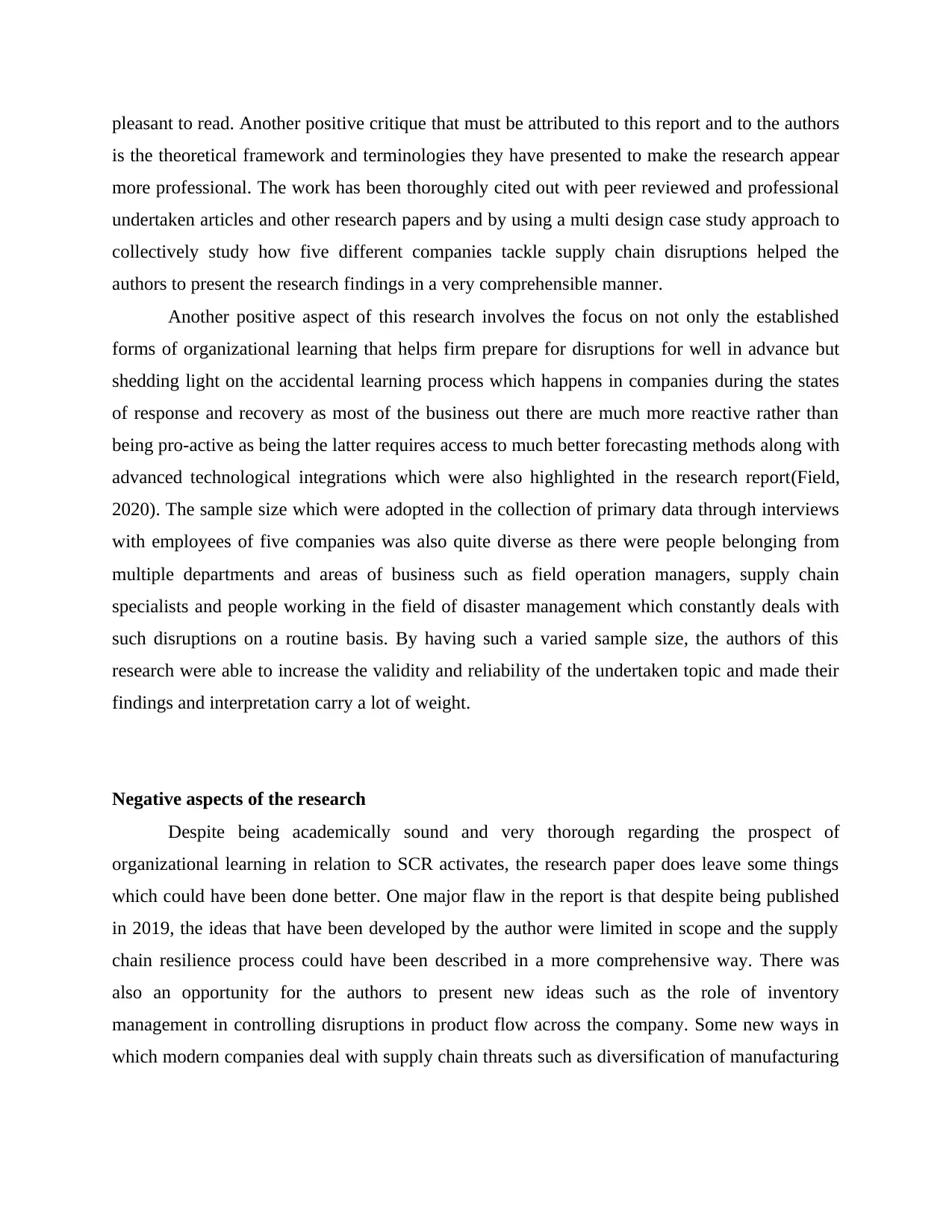
pleasant to read. Another positive critique that must be attributed to this report and to the authors
is the theoretical framework and terminologies they have presented to make the research appear
more professional. The work has been thoroughly cited out with peer reviewed and professional
undertaken articles and other research papers and by using a multi design case study approach to
collectively study how five different companies tackle supply chain disruptions helped the
authors to present the research findings in a very comprehensible manner.
Another positive aspect of this research involves the focus on not only the established
forms of organizational learning that helps firm prepare for disruptions for well in advance but
shedding light on the accidental learning process which happens in companies during the states
of response and recovery as most of the business out there are much more reactive rather than
being pro-active as being the latter requires access to much better forecasting methods along with
advanced technological integrations which were also highlighted in the research report(Field,
2020). The sample size which were adopted in the collection of primary data through interviews
with employees of five companies was also quite diverse as there were people belonging from
multiple departments and areas of business such as field operation managers, supply chain
specialists and people working in the field of disaster management which constantly deals with
such disruptions on a routine basis. By having such a varied sample size, the authors of this
research were able to increase the validity and reliability of the undertaken topic and made their
findings and interpretation carry a lot of weight.
Negative aspects of the research
Despite being academically sound and very thorough regarding the prospect of
organizational learning in relation to SCR activates, the research paper does leave some things
which could have been done better. One major flaw in the report is that despite being published
in 2019, the ideas that have been developed by the author were limited in scope and the supply
chain resilience process could have been described in a more comprehensive way. There was
also an opportunity for the authors to present new ideas such as the role of inventory
management in controlling disruptions in product flow across the company. Some new ways in
which modern companies deal with supply chain threats such as diversification of manufacturing
is the theoretical framework and terminologies they have presented to make the research appear
more professional. The work has been thoroughly cited out with peer reviewed and professional
undertaken articles and other research papers and by using a multi design case study approach to
collectively study how five different companies tackle supply chain disruptions helped the
authors to present the research findings in a very comprehensible manner.
Another positive aspect of this research involves the focus on not only the established
forms of organizational learning that helps firm prepare for disruptions for well in advance but
shedding light on the accidental learning process which happens in companies during the states
of response and recovery as most of the business out there are much more reactive rather than
being pro-active as being the latter requires access to much better forecasting methods along with
advanced technological integrations which were also highlighted in the research report(Field,
2020). The sample size which were adopted in the collection of primary data through interviews
with employees of five companies was also quite diverse as there were people belonging from
multiple departments and areas of business such as field operation managers, supply chain
specialists and people working in the field of disaster management which constantly deals with
such disruptions on a routine basis. By having such a varied sample size, the authors of this
research were able to increase the validity and reliability of the undertaken topic and made their
findings and interpretation carry a lot of weight.
Negative aspects of the research
Despite being academically sound and very thorough regarding the prospect of
organizational learning in relation to SCR activates, the research paper does leave some things
which could have been done better. One major flaw in the report is that despite being published
in 2019, the ideas that have been developed by the author were limited in scope and the supply
chain resilience process could have been described in a more comprehensive way. There was
also an opportunity for the authors to present new ideas such as the role of inventory
management in controlling disruptions in product flow across the company. Some new ways in
which modern companies deal with supply chain threats such as diversification of manufacturing
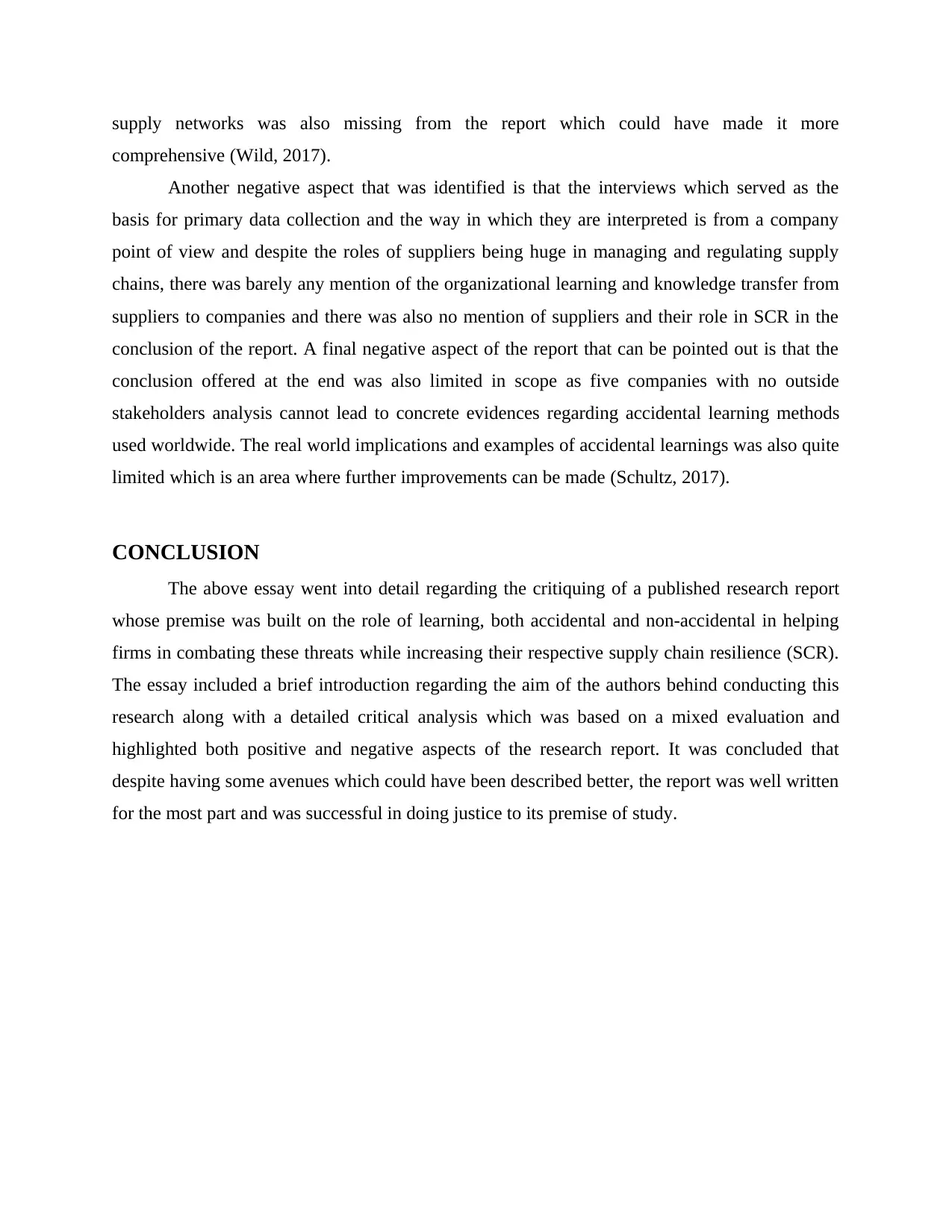
supply networks was also missing from the report which could have made it more
comprehensive (Wild, 2017).
Another negative aspect that was identified is that the interviews which served as the
basis for primary data collection and the way in which they are interpreted is from a company
point of view and despite the roles of suppliers being huge in managing and regulating supply
chains, there was barely any mention of the organizational learning and knowledge transfer from
suppliers to companies and there was also no mention of suppliers and their role in SCR in the
conclusion of the report. A final negative aspect of the report that can be pointed out is that the
conclusion offered at the end was also limited in scope as five companies with no outside
stakeholders analysis cannot lead to concrete evidences regarding accidental learning methods
used worldwide. The real world implications and examples of accidental learnings was also quite
limited which is an area where further improvements can be made (Schultz, 2017).
CONCLUSION
The above essay went into detail regarding the critiquing of a published research report
whose premise was built on the role of learning, both accidental and non-accidental in helping
firms in combating these threats while increasing their respective supply chain resilience (SCR).
The essay included a brief introduction regarding the aim of the authors behind conducting this
research along with a detailed critical analysis which was based on a mixed evaluation and
highlighted both positive and negative aspects of the research report. It was concluded that
despite having some avenues which could have been described better, the report was well written
for the most part and was successful in doing justice to its premise of study.
comprehensive (Wild, 2017).
Another negative aspect that was identified is that the interviews which served as the
basis for primary data collection and the way in which they are interpreted is from a company
point of view and despite the roles of suppliers being huge in managing and regulating supply
chains, there was barely any mention of the organizational learning and knowledge transfer from
suppliers to companies and there was also no mention of suppliers and their role in SCR in the
conclusion of the report. A final negative aspect of the report that can be pointed out is that the
conclusion offered at the end was also limited in scope as five companies with no outside
stakeholders analysis cannot lead to concrete evidences regarding accidental learning methods
used worldwide. The real world implications and examples of accidental learnings was also quite
limited which is an area where further improvements can be made (Schultz, 2017).
CONCLUSION
The above essay went into detail regarding the critiquing of a published research report
whose premise was built on the role of learning, both accidental and non-accidental in helping
firms in combating these threats while increasing their respective supply chain resilience (SCR).
The essay included a brief introduction regarding the aim of the authors behind conducting this
research along with a detailed critical analysis which was based on a mixed evaluation and
highlighted both positive and negative aspects of the research report. It was concluded that
despite having some avenues which could have been described better, the report was well written
for the most part and was successful in doing justice to its premise of study.
⊘ This is a preview!⊘
Do you want full access?
Subscribe today to unlock all pages.

Trusted by 1+ million students worldwide
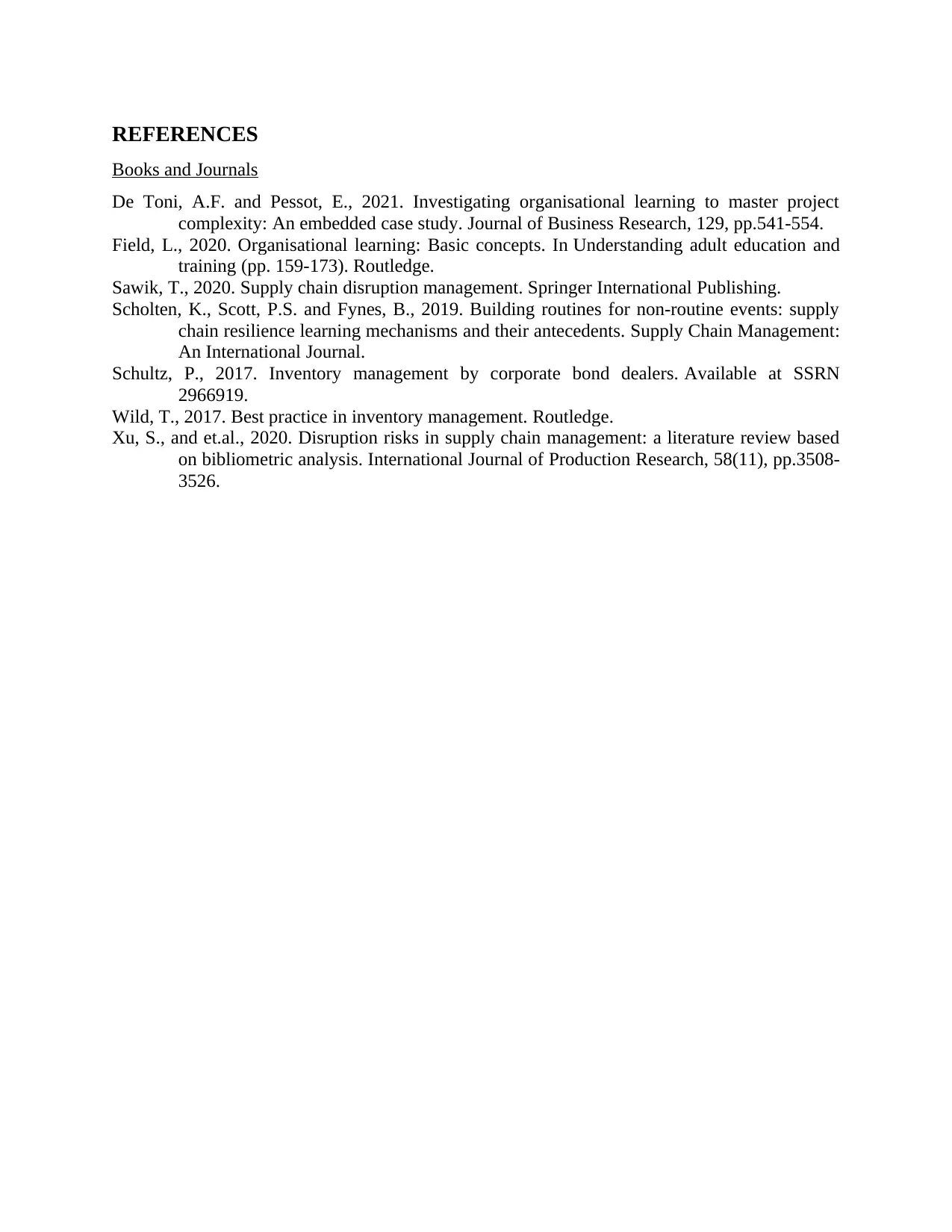
REFERENCES
Books and Journals
De Toni, A.F. and Pessot, E., 2021. Investigating organisational learning to master project
complexity: An embedded case study. Journal of Business Research, 129, pp.541-554.
Field, L., 2020. Organisational learning: Basic concepts. In Understanding adult education and
training (pp. 159-173). Routledge.
Sawik, T., 2020. Supply chain disruption management. Springer International Publishing.
Scholten, K., Scott, P.S. and Fynes, B., 2019. Building routines for non-routine events: supply
chain resilience learning mechanisms and their antecedents. Supply Chain Management:
An International Journal.
Schultz, P., 2017. Inventory management by corporate bond dealers. Available at SSRN
2966919.
Wild, T., 2017. Best practice in inventory management. Routledge.
Xu, S., and et.al., 2020. Disruption risks in supply chain management: a literature review based
on bibliometric analysis. International Journal of Production Research, 58(11), pp.3508-
3526.
Books and Journals
De Toni, A.F. and Pessot, E., 2021. Investigating organisational learning to master project
complexity: An embedded case study. Journal of Business Research, 129, pp.541-554.
Field, L., 2020. Organisational learning: Basic concepts. In Understanding adult education and
training (pp. 159-173). Routledge.
Sawik, T., 2020. Supply chain disruption management. Springer International Publishing.
Scholten, K., Scott, P.S. and Fynes, B., 2019. Building routines for non-routine events: supply
chain resilience learning mechanisms and their antecedents. Supply Chain Management:
An International Journal.
Schultz, P., 2017. Inventory management by corporate bond dealers. Available at SSRN
2966919.
Wild, T., 2017. Best practice in inventory management. Routledge.
Xu, S., and et.al., 2020. Disruption risks in supply chain management: a literature review based
on bibliometric analysis. International Journal of Production Research, 58(11), pp.3508-
3526.
1 out of 7
Related Documents
Your All-in-One AI-Powered Toolkit for Academic Success.
+13062052269
info@desklib.com
Available 24*7 on WhatsApp / Email
![[object Object]](/_next/static/media/star-bottom.7253800d.svg)
Unlock your academic potential
Copyright © 2020–2025 A2Z Services. All Rights Reserved. Developed and managed by ZUCOL.





